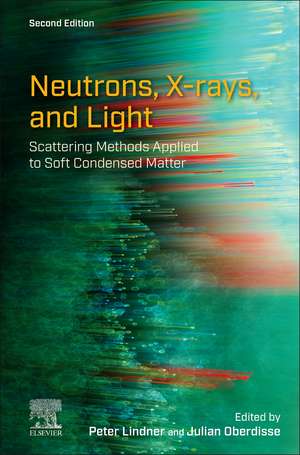Neutrons, X-rays, and Light: Scattering Methods Applied to Soft Condensed Matter
Editat de Peter Lindner, Julian Oberdisseen Limba Engleză Hardback – 10 dec 2024
Part 1 of the book is dedicated to the use of general principles for the measurement and analysis of scattered intensity: elementary scattering process, data reduction, general theorems, the concept of reciprocal space, and its link to structural and dynamical information in direct space. In Part 2, methods and techniques are further discussed, including resolution effects, contrast variation, static and dynamic light scattering, quasielastic neutron scattering, and reflectometry and grazing incidence techniques. Part 3 deals with the state of the art of scattering studies of typical soft matter systems (polymers, self-assembled surfactant systems and liquid crystals, microemulsions, colloids, aggregates, biological systems) with dedicated chapters for particle interactions and modeling. Part 4 highlights special applications, from light scattering in turbid media to scattering under external constraints, applications of neutron reflectometry, characterization of relaxation modes by neutron spectroscopy, and industrial applications.
This new edition, written by the lecturers of the Bombannes Summer School, will be most useful as a learning tool for masters and PhD students, postdocs, and young researchers moving into the field. As with the previous edition, it will also be a reference for any scientist working in soft matter, where scattering techniques are ubiquitous, used in both small laboratories and large-scale research facilities.
- Provides an understandable and thorough introduction to the fundamentals of scattering in a way that is accessible for masters and PhD students
- Offers a comprehensive overview of the key scattering techniques associated with neutrons, X-rays, and light
- Includes chapters on the most relevant soft matter systems
- Presents both standard analyses and recent advances in scattering techniques
Preț: 1153.90 lei
Preț vechi: 1539.07 lei
-25% Nou
Puncte Express: 1731
Preț estimativ în valută:
220.80€ • 240.59$ • 186.05£
220.80€ • 240.59$ • 186.05£
Carte tipărită la comandă
Livrare economică 16-30 aprilie
Preluare comenzi: 021 569.72.76
Specificații
ISBN-13: 9780443291166
ISBN-10: 0443291160
Pagini: 806
Dimensiuni: 191 x 235 mm
Greutate: 1.58 kg
Ediția:2
Editura: ELSEVIER SCIENCE
ISBN-10: 0443291160
Pagini: 806
Dimensiuni: 191 x 235 mm
Greutate: 1.58 kg
Ediția:2
Editura: ELSEVIER SCIENCE
Cuprins
Part 1 Using General Principles
1. General Introduction: Soft Matter Systems and Scattering Experiments
2. General Theorems, Differential Scattering Cross-Section, and Initial Data Treatment
3. The Inverse Scattering Problem
4. Indirect Fourier Transformation, Deconvolution and Generalized Indirect Fourier Transformation
Part 2 Methods
5. Instrumentation & Resolution Effects for Small-Angle X-ray & Neutron Scattering
6. Contrast & Contrast Variation in Neutron, X-ray and Light Scattering
7. Static Light Scattering
8. Dynamic Light Scattering
10. Neutron & X-ray Reflectivity and Grazing Incidence Scattering
Part 3 Revealing Microstructures and Dynamics of Soft Condensed Matter
11. Introduction to Polymers - Static Scattering
12. Self Assembled Aggregates: form and structure factor in surfactant systems and lyotropic liquid crystals
13. Small-Angle Scattering by Microemulsions
14. Interacting Colloidal Systems, Gels, Glasses
15. Model Fitting and Simulation Techniques for Small-Angle Scattering Data Analysis
16. Polymer Dynamics
17. Analysis of Small-Angle Scattering Data of Complex Biological Systems
18. Macromolecular and Supramolecular Assemblies
Part 4 Special Applications
19. Soft Matter Studies Under Non-Equilibrium Conditions
20. Polymer Processing: Application of Scattering Methods to Polyurethane Materials
21. Light Scattering in Turbid Media
22. From Real to Reciprocal Space: Scattering Information from Real Space Images
23. Use of Scattering Techniques in Industry
24. Applications of Neutron Reflectometry to Soft Matter and Biological Systems
25. Using Weak Aggregation for Solubilization and Separation
26. Quasi-elastic Neutron Scattering Spectroscopy: characterisation of relaxation modes at the molecular scale
1. General Introduction: Soft Matter Systems and Scattering Experiments
2. General Theorems, Differential Scattering Cross-Section, and Initial Data Treatment
3. The Inverse Scattering Problem
4. Indirect Fourier Transformation, Deconvolution and Generalized Indirect Fourier Transformation
Part 2 Methods
5. Instrumentation & Resolution Effects for Small-Angle X-ray & Neutron Scattering
6. Contrast & Contrast Variation in Neutron, X-ray and Light Scattering
7. Static Light Scattering
8. Dynamic Light Scattering
10. Neutron & X-ray Reflectivity and Grazing Incidence Scattering
Part 3 Revealing Microstructures and Dynamics of Soft Condensed Matter
11. Introduction to Polymers - Static Scattering
12. Self Assembled Aggregates: form and structure factor in surfactant systems and lyotropic liquid crystals
13. Small-Angle Scattering by Microemulsions
14. Interacting Colloidal Systems, Gels, Glasses
15. Model Fitting and Simulation Techniques for Small-Angle Scattering Data Analysis
16. Polymer Dynamics
17. Analysis of Small-Angle Scattering Data of Complex Biological Systems
18. Macromolecular and Supramolecular Assemblies
Part 4 Special Applications
19. Soft Matter Studies Under Non-Equilibrium Conditions
20. Polymer Processing: Application of Scattering Methods to Polyurethane Materials
21. Light Scattering in Turbid Media
22. From Real to Reciprocal Space: Scattering Information from Real Space Images
23. Use of Scattering Techniques in Industry
24. Applications of Neutron Reflectometry to Soft Matter and Biological Systems
25. Using Weak Aggregation for Solubilization and Separation
26. Quasi-elastic Neutron Scattering Spectroscopy: characterisation of relaxation modes at the molecular scale
